Duchenne muscular dystrophy is caused by a sex-linked recessive allele. Its victims are almost invariably boys, who usually die before the age of 20. Why is this disorder almost never seen in girls?
- The allele is carried on the Y chromosome.
- Nondisjunction occurs in males but not in females.
- A sex-linked allele cannot be passed from mother to daughter.
- To express an X-linked recessive allele, a female must have two copies of the allele.
- Sex-linked traits are never seen in girls.
To express an X-linked recessive allele, a female must have two copies of the allele.
Ex.
Duchenne muscular dystrophy is caused by a sex-linked recessive allele. Its victims are almost invariably boys, who usually die before the age of 20. This disorder is almost never seen in girls because to express an X-linked recessive allele, a female must have two copies of the allele.
The human X chromosome contains approximately 1,100 genes, which are called X-linked genes. The fact that males and females inherit a different number of X chromosomes leads to a pattern of inheritance different from that produced by genes located on autosomes. Fathers pass X-linked alleles to all of their daughters but to none of their sons. In contrast, mothers can pass X-linked alleles to both sons and daughters. An example is Duchenne muscular dystrophy, which affects about one out of every 3,500 males born in the United States. The disease is characterized by a progressive weakening of the muscles and loss of coordination. In order to express an X-linked recessive allele, a female must have two copies of the allele. In addition, males carrying the allele have less of an opportunity to have offspring.
An X-linked gene causes Duchenne muscular dystrophy, not a gene on the Y chromosome. Nondisjunction occurs in both males and females. A daughter receives an X chromosome from her mother, so a sex-linked allele can be passed on in this fashion.
In Klinefelter syndrome, individuals are phenotypically male, but have reduced sperm production and may have some breast development in adolescence. The cells of Klinefelter individuals have two X chromosomes and one Y (they are XXY instead of XY).
This occurs because of what meiotic error?
- Translocation
- Polyploidy
- Aneuploidy
- Duplication
- Monosomy
Aneuploidy
Ex.
In Klinefelter syndrome, individuals are phenotypically male, but have reduced sperm production and may have some breast development in adolescence. The cells of Klinefelter individuals have two X chromosomes and one Y (they are XXY instead of XY). This occurs because of aneuploidy.
Ideally, the meiotic spindle distributes chromosomes to daughter cells without error. But there is an occasional mishap, called a nondisjunction, in which the members of a pair of homologous chromosomes do not move apart properly during meiosis I or sister chromatids fail to separate during meiosis II. In these cases, one gamete receives two of the same type of chromosome and another gamete receives no copy. The other chromosomes are usually distributed normally. If either of the aberrant gametes unites with a normal one at fertilization, the zygote will also have an abnormal number of a particular chromosome, a condition known as aneuploidy. Nondisjunction of sex chromosomes produces a variety of aneuploid conditions. Having an extra X chromosome affects males much more than females. In males, the extra X chromosome causes Klinefelter syndrome: abnormally small testes and sterility; some breast enlargement and other female body characteristics; and intelligence may be subnormal.
A translocation occurs when fragments produced by chromosomal breakage join nonhomologous chromosomes. Polyploidy refers to a condition in which a cell has more than two complete chromosomal sets. Duplication refers to the presence of additional segments within a single chromosome, not to the presence of additional chromosomes. Monosomy means one chromosome too few.
In an X-linked, or sex-linked, trait, it is the contribution of __________ that determines whether a son will display the trait.
- the paternal grandmother
- the father
- the mother
- the paternal grandfather
- None of the listed responses is correct.
the mother
Ex.
In an X-linked, or sex-linked, trait, it is the contribution of the mother that determines whether a son will display the trait.
In humans and other mammals, there are two varieties of sex chromosomes, designated X and Y. The Y chromosome is much smaller than the X chromosome. A person who inherits two X chromosomes, one from each parent, usually develops as a female. A male develops from a zygote containing one X chromosome and one Y chromosome. Each egg contains one X chromosome. In contrast, sperm fall into two categories: Half the sperm cells a male produces contain an X chromosome, and half contain a Y chromosome. We can trace the sex of each offspring to the events of conception: If a sperm cell bearing an X chromosome happens to fertilize an egg, the zygote is XX, a female; if a sperm cell containing a Y chromosome fertilizes an egg, the zygote is XY, a male. The human X chromosome contains approximately 1,100 genes, which are called X-linked genes. The fact that males and females inherit a different number of X chromosomes leads to a pattern of inheritance different from that produced by genes located on autosomes. Fathers pass X-linked alleles to all of their daughters but to none of their sons. In contrast, mothers can pass X-linked alleles to both sons and daughters. The son receives his single X chromosome from his mother and the Y from his father.
A son does not inherit an X from his father. A male cannot trace his X chromosome to his paternal grandmother. However, a male can trace his Y chromosome to his paternal grandfather.
In werewolves (hypothetically), pointy ears (P) are dominant over round ears (p). The gene is on the X chromosome. (Sex determination in werewolves is the same as for "other" humans.) A certain female werewolf has pointy ears even though her father had round ears.
What percentage of her sons will have round ears if she mates with a werewolf with round ears?
50%
Ex.
In werewolves (hypothetically), pointy ears (P) are dominant over round ears (p). The gene is on the X chromosome. (Sex determination in werewolves is the same as for "other" humans.) A certain female werewolf has pointy ears even though her father had round ears. 50% of her sons will have round ears if she mates with a werewolf with round ears.
The human X chromosome contains approximately 1,100 genes, which are called X-linked genes. The fact that males and females inherit a different number of X chromosomes leads to a pattern of inheritance different from that produced by genes located on autosomes. Fathers pass X-linked alleles to all of their daughters but to none of their sons. In contrast, mothers can pass X-linked alleles to both sons and daughters. The female werewolf must be heterozygous, because her father has round ears. Each of her sons has a 50 percent chance of inheriting the round allele.
Gene silencing is called __________.
- a linkage analysis
- a mitochondrial effect
- genomic imprinting
- a translocation
- polyploidism
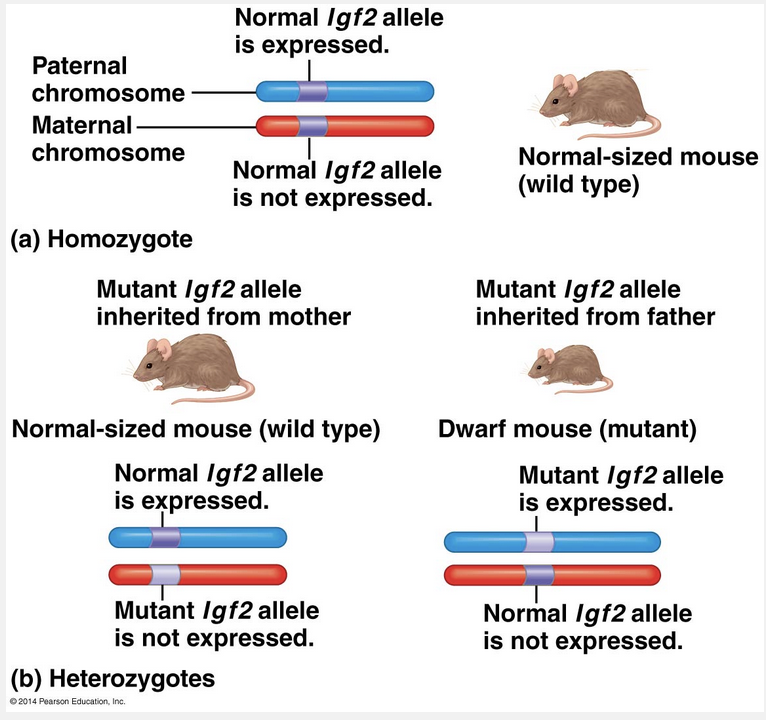
genomic imprinting
Ex.
Gene silencing is called genomic imprinting.
Genomic imprinting occurs during gamete formation and results in the silencing of a particular allele of certain genes. Because these genes are imprinted differently in sperm and in eggs, the offspring expresses only one allele of an imprinted gene, the allele that has been inherited from either the female or the male parent. The imprints are then transmitted to all body cells during development. In each generation, the old imprints are “erased” from gamete-producing cells, and the chromosomes of the developing gametes are newly imprinted according to the sex of the individual forming the gametes. In a given species, the imprinted genes are always imprinted in the same way. For instance, a gene imprinted for maternal allele expression is always imprinted this way, generation after generation. Genomic imprinting thus seems to consist of methyl (–CH 3 ) groups that are added to cytosine nucleotides of one of the alleles. Such methylation may silence the allele, an effect consistent with the evidence that heavily methylated genes are usually inactive.
“A linkage analysis,” “a translocation,” and “mitochondrial effect” are incorrect because gene silencing involves genomic imprinting during gamete formation. “Polyploidism” is incorrect because this is not a term used in genetics.
X inactivation occurs when there is/are at least __________ X chromosomes present in an individual, forming a structure called a __________ by a __________ event.
- two; chromosomal body; specific
- two; Barr body; random
- two; chromosomal body; random
- one; Barr body; specific
- one; Barr body; random
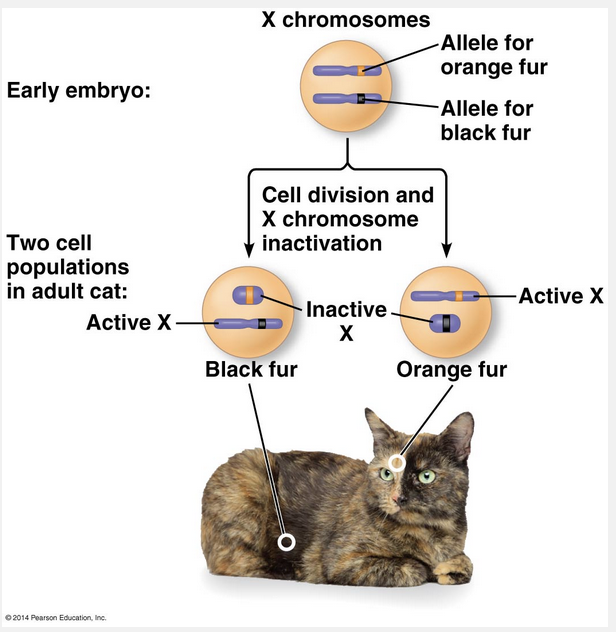
two; Barr body; random
Ex.
X inactivation occurs when there are at least two X chromosomes present in an individual, forming a structure called a Barr body by a random event.
Female mammals, including human females, inherit two X chromosomes—twice the number inherited by males—so you may wonder whether females make twice as much of the proteins encoded by X-linked genes as males make. In fact, almost all of one X chromosome in each cell in female mammals becomes inactivated during early embryonic development. As a result, the cells of females and males have the same effective dose (one copy) of most X-linked genes. The inactive X in each cell of a female condenses into a compact object called a Barr body (discovered by Canadian anatomist Murray Barr), which lies along the inside of the nuclear envelope. British geneticist Mary Lyon demonstrated that the selection of which X chromosome forms the Barr body occurs randomly and independently in each embryonic cell present at the time of X inactivation.
Female mammals have two X chromosomes, one from their mother and one from their father. During X inactivation, one X chromosome in each embryonic cell is randomly inactivated; therefore, all of the tissues that arise from that cell have the same inactivated X chromosome. Female mammals are therefore considered to be __________ of the maternal and paternal cells.
- a recombinant
- a blending
- a mosaic
- a fusion
- homozygotes

a mosaic
Ex.
Female mammals have two X chromosomes, one from their mother and one from their father. During X inactivation, one X chromosome in each embryonic cell is randomly inactivated; therefore, all of the tissues that arise from that cell have the same inactivated X chromosome. Female mammals are therefore considered to be a mosaic of the maternal and paternal cells.
British geneticist Mary Lyon demonstrated that the selection of which X chromosome forms the Barr body occurs randomly and independently in each embryonic cell present at the time of X inactivation. As a consequence, females consist of a mosaic of two types of cells: those with the active X derived from the father and those with the active X derived from the mother. After an X chromosome is inactivated in a particular cell, all mitotic descendants of that cell have the same inactive X. Thus, if a female is heterozygous for a sex-linked trait, about half her cells express one allele, and the others express the alternate allele. The illustration above shows how this mosaicism results in the mottled coloration of a tortoiseshell cat. In humans, mosaicism can be observed in a recessive X-linked mutation that prevents the development of sweat glands. A woman who is heterozygous for this trait has patches of normal skin and patches of skin lacking sweat glands.
“A blending,” “a fusion,” “a recombinant,” and “homozygotes” are all incorrect because
X inactivation randomly and independently inactivates an X in each embryonic cell. As a consequence, females consist of a mosaic of two types of cells: those with the active X derived from the father and those with the active X derived from the mother.
When an individual has an additional chromosome, that chromosome set is called __________, and the condition is known as __________.
- monosomic; aneuploidy
- trisomic; polyploidy
- monosomic; haploidy
- trisomic; aneuploidy
- trisomic; haploidy
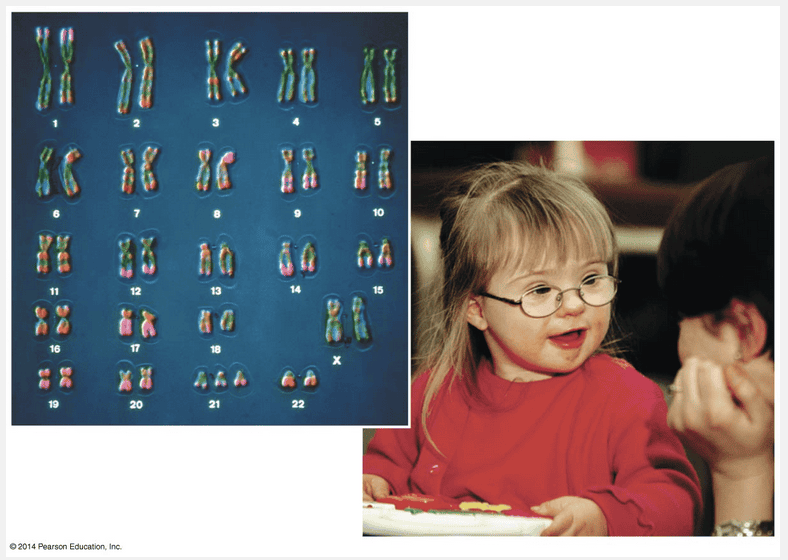
trisomic; aneuploidy
Ex.
When an individual has an additional chromosome, that chromosome set is called trisomic, and the condition is known as aneuploidy.
If either of the aberrant gametes unites with a normal gamete at fertilization, the zygote will also have an abnormal number of a particular chromosome, a condition known as aneuploidy. On the other hand, fertilization involving a gamete that has no copy of a particular chromosome will lead to a missing chromosome in the zygote (and thus the cell has 2 n – 1 chromosomes); the aneuploid zygote is said to be monosomic for that chromosome. If a chromosome is present in triplicate in the zygote (and thus the cell has 2 n + 1 chromosomes), the aneuploid cell is trisomic for that chromosome.
“Monosomic; haploidy” and “monosomic; aneuploidy” are incorrect because an additional chromosome results in three copies of the same chromosome. When an individual has extra or missing chromosomes, the condition is known as aneuploidy. “Trisomic; haploidy” and “trisomic; polyploidy” are incorrect because even though “trisomic” is correct, an individual who has extra or missing chromosomes has a condition known as aneuploidy, not haploidy or polyploidy.

Down syndrome is an example of __________, and the child is __________ for chromosome 21.
- haploidy; monosomic
- polyploidy; monosomic
- aneuploidy; trisomic
- aneuploidy; monosomic
- polyploidy; trisomic
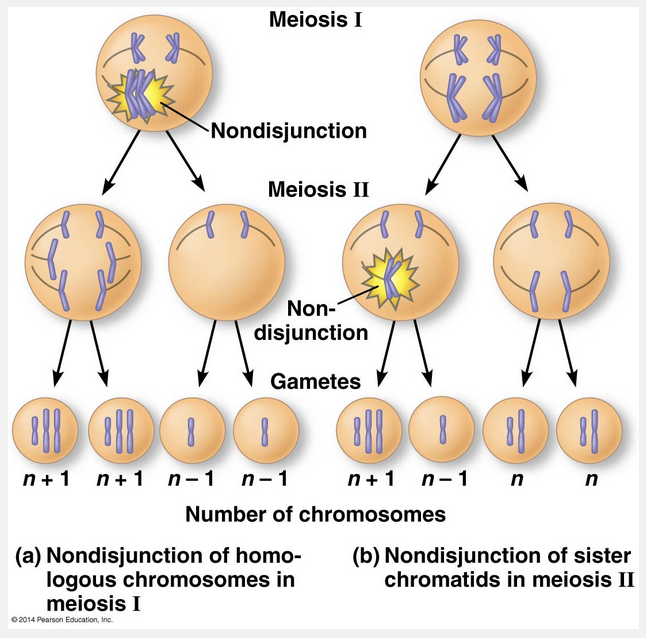
aneuploidy; trisomic
Ex.
Down syndrome is an example of aneuploidy , and the child is trisomic for chromosome 21.
Down syndrome affects approximately one out of every 830 children born in the United States and is usually the result of an extra chromosome 21; thus each body cell has a total of 47 chromosomes. Because the cells are trisomic for chromosome 21, Down syndrome is often called trisomy 21.
“Aneuploidy; monosomic” is incorrect because in Down syndrome, the child inherits three copies of chromosome 21 and has aneuploidy. “Polyploidy; trisomic” and “polyploidy; monosomic” are incorrect because polyploidy refers to more than two complete sets of chromosomes, and in Down syndrome, the child inherits one extra copy of one chromosome, chromosome 21. “Haploidy; monosomic” is incorrect because humans are diploid and only their gametes are haploid.
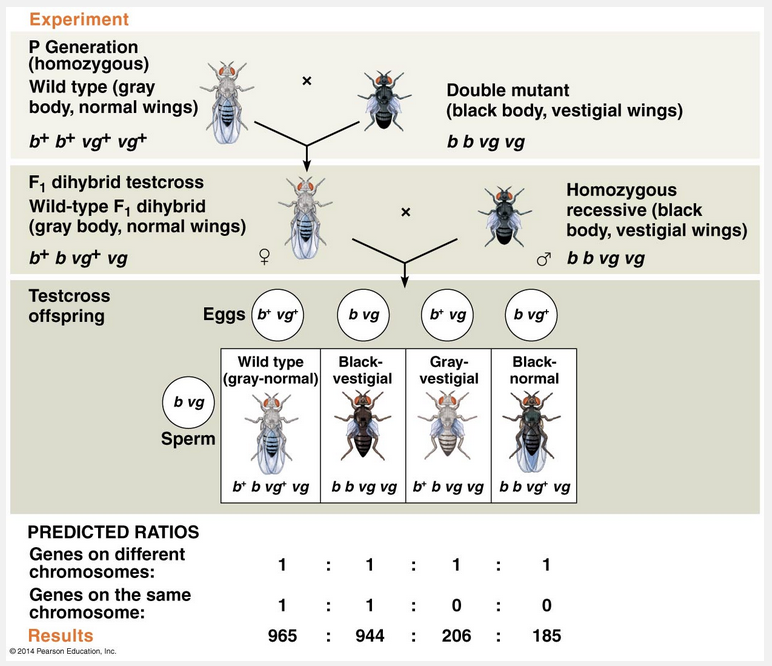
Linked genes __________.
- are found only in Drosophila
- are located on the same chromosome, but one gene is closer to the centromere while the other gene is closer to the end of the arm
- are located on the same chromosome but at opposite ends of the arms
- are found only on sister chromatids
- are located near each other on the same chromosome
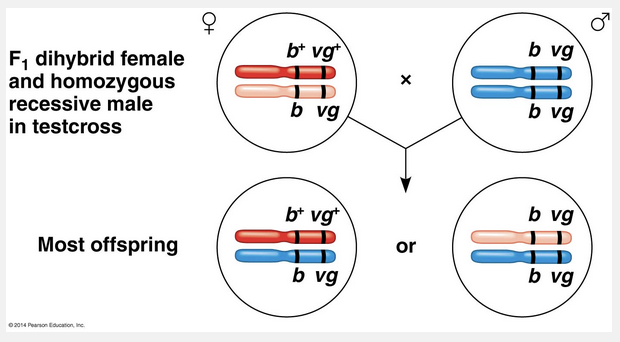
are located near each other on the same chromosome
Ex.
Linked genes are located near each other on the same chromosome.
The number of genes in a cell is far greater than the number of chromosomes; in fact, each chromosome (except the Y) has hundreds or thousands of genes. Genes located near each other on the same chromosome tend to be inherited together in genetic crosses; such genes are said to be genetically linked and are called linked genes. When geneticists follow linked genes in breeding experiments, the results deviate from those that would be expected from Mendel’s law of independent assortment.
To see how linkage between genes affects the inheritance of two different characters, let’s examine another of Morgan’s Drosophila experiments. In this case, the characters are body color and wing size, each of which has two different phenotypes. Wild-type flies have gray bodies and normal-sized wings. In addition to these flies, Morgan managed to obtain, through breeding, doubly mutant flies with black bodies and wings much smaller than normal, called vestigial wings. The mutant alleles were recessive to the wild-type alleles, and neither gene was on a sex chromosome. In his investigation of these two genes, Morgan carried out the crosses shown in this figure:
The first was a P generation cross to generate F1 dihybrid flies, and the second was a testcross. The resulting flies had a much higher proportion of the combinations of traits seen in the P generation flies (called parental phenotypes) than would have been expected if the two genes had assorted independently. Morgan thus concluded that body color and wing size are usually inherited together in specific (parental) combinations because the genes for these characters are near each other on the same chromosome.
“Are located on the same chromosome but at opposite ends of the arms,” “are located on the same chromosome, but one gene is closer to the centromere while the other gene is closer to the end of the arm,” and “are found only on sister chromatids” are incorrect because genes located near each other on the same chromosome tend to be inherited together in genetic crosses; such genes are said to be genetically linked and are called linked genes. “Are found only in Drosophila” is incorrect because in all organisms, the number of genes in a cell is far greater than the number of chromosomes; in fact, each chromosome (except the Y) has hundreds or thousands of genes. Genes located near each other on the same chromosome tend to be inherited together in genetic crosses.
You perform a testcross using F1 dihybrid flies. If, in the resulting offspring, the percentages of parental and recombinant offspring are about the same, this would indicate that the two genes are __________.
- imprinted
- similar in DNA sequence
- linked
- unlinked
- mutated
unlinked
Ex.
You perform a testcross using F1 dihybrid flies. If, in the resulting offspring, the percentages of parental and recombinant offspring are about the same, this would indicate that the two genes are unlinked.
Genes located near each other on the same chromosome tend to be inherited together in genetic crosses; such genes are said to be genetically linked and are called linked genes. When geneticists follow linked genes in breeding experiments, the results deviate from those expected from Mendel’s law of independent assortment. To see how linkage between genes affects the inheritance of two different characters, let’s examine another of Morgan’s Drosophila experiments. In this case, the characters are body color and wing size, each with two different phenotypes. Wild-type flies have gray bodies and normal-sized wings. In addition to these flies, Morgan had managed to obtain, through breeding, doubly mutant flies with black bodies and wings much smaller than normal, called vestigial wings. The mutant alleles are recessive to the wild-type alleles, and neither gene is on a sex chromosome. In his investigation of these two genes, Morgan carried out a variety of crosses. The first was a P generation cross to generate F1 dihybrid flies, and the second was a testcross. The resulting flies had a much higher proportion of the combinations of traits seen in the P generation flies (called parental phenotypes) than would be expected if the two genes assorted independently. The genes in this case would be unlinked and on different chromosomes because the percentage of parental and recombinant offspring are about the same.
An excess number of parental over recombinant offspring would have indicated linkage. The relative proportions of parental and recombinant offspring give clues regarding linkage, not DNA sequence. The relative proportions of parental and recombinant offspring give clues regarding linkage, not whether the genes are mutant or not. Imprinting refers to the sex-specific inactivation of certain genes during gametogenesis.
__________ is the failure of __________ to separate in meiosis I or the failure of __________ to separate in meiosis II.
- Nondisjunction; homologous chromosomes; sister chromatids
- Nondisjunction; sister chromatids; homologous chromosomes
- Disjunction; homologous chromosomes; sister chromatids
- Disjunction; sister chromatids; homologous chromosomes
- Aneuploidy; sister chromatids; homologous chromosomes

Nondisjunction; homologous chromosomes; sister chromatids
Ex.
Nondisjunction is the failure of homologous chromosomes to separate in meiosis I or the failure of sister chromatids to separate in meiosis II.
A mishap called a nondisjunction occurs when members of a pair of homologous chromosomes do not move apart properly during meiosis I or when sister chromatids fail to separate during meiosis II. In nondisjunction, one gamete receives two of the same type of chromosome, and another gamete receives no copy of that chromosome. The other chromosomes are usually distributed normally.
“Nondisjunction; sister chromatids; homologous chromosomes,” “disjunction; homologous chromosomes; sister chromatids,” “disjunction; sister chromatids; homologous chromosomes,” and “aneuploidy; sister chromatids; homologous chromosomes” are incorrect because the homologous chromosomes separate in meiosis I while sister chromatids separate in meiosis II. Nondisjunction is the failure of either homologous chromosomes or sister chromatids to separate.
What appears to be the mechanism for genomic imprinting?
- Crossing over
- Nondisjunction
- DNA methylation that silences particular genes and DNA methylation that activates particular genes
- DNA methylation that silences particular genes
- DNA methylation that activates particular genes
DNA methylation that silences particular genes and DNA methylation that activates particular genes
Ex.
DNA methylation that silences particular genes and DNA methylation that activates particular genes appears to be the mechanism for genomic imprinting.
In recent years, geneticists have identified two to three dozen traits in mammals that depend on which parent passed along the alleles for those traits. Such variation in phenotype depending on whether an allele is inherited from the male or female parent is called genomic imprinting. Genomic imprinting occurs during gamete formation and results in the silencing of a particular allele of certain genes. Because these genes are imprinted differently in sperm and eggs, a zygote expresses only one allele of an imprinted gene, which it inherited from either the female or the male parent. What exactly is a genomic imprint? In many cases, it seems to consist of methyl (–CH3) groups that are added to cytosine nucleotides of one of the alleles.
Such methylation may silence the allele, an effect consistent with evidence that heavily methylated genes are usually inactive. However, for a few genes, methylation has been shown to activate expression of the allele. Crossing over does not appear to play a part in genomic imprinting. Nondisjunction does not appear to play a role in genomic imprinting.
Wild type refers to __________.
- the most common phenotype thought to be found in the natural population
- extranuclear genes
- a kind of chromosomal deletion
- any mutant genotype
- the most extreme mutant phenotype observed in an experiment
the most common phenotype thought to be found in the natural population
Ex.
Wild type refers to the most common phenotype thought to be found in the natural population.
The phenotype for a character most commonly observed in natural populations, such as red eyes in Drosophila, is called the wild type. Traits that are alternatives to the wild type, such as white eyes in Drosophila, are called mutant phenotypes because they are due to alleles assumed to have originated as changes, or mutations, in the wild-type allele.
Wild type refers to a phenotype, not a genotype a chromosomal deletion. Wild-type phenotypes are not due to extranuclear genes.
In a certain fish, fin rays (supporting structures for the fins) can be either bony or soft in adult fish. Sex linkage in a fish is similar to that in humans. What evidence would most strongly support the idea that the ray locus is on the X chromosome?
- Matings of soft ray males and bony ray females give different results from the matings of bony ray males and soft ray females.
- Females with bony rays cannot pass bony rays to female offspring even if they are mating with a bony ray male.
- Females with either bony or soft rays can reproduce, but males with soft rays cannot transfer sperm to the female.
- All of the listed responses are correct.
- Bony ray males can pass on bony rays only to their male offspring.
Matings of soft ray males and bony ray females give different results from the matings of bony ray males and soft ray females.
Ex.
In a certain fish, fin rays (supporting structures for the fins) can be either bony or soft in adult fish. Sex linkage in a fish is similar to that in humans. The evidence that would most strongly support the idea that the ray locus is on the X chromosome is that matings of soft ray males and bony ray females give different results from the matings of bony ray males and soft ray females.
X-linked genes in many animals, including fish, follow the same pattern of inheritance that Morgan observed for the eye-color locus he studied in Drosophila. Fathers pass X-linked alleles to all of their daughters but to none of their sons. In contrast, mothers can pass X-linked alleles to both sons and daughters. Genes affecting sex-linked traits will give particular sex ratios in the offspring, and reciprocal crosses (males with the dominant trait crossed with females with the recessive trait, and males with the recessive trait crossed with females with the dominant trait) would not have the same results.
Bony ray males passing on this trait only to their male offspring would support Y-linkage. An ability or inability to reproduce is not indicative of sex linkage. Females can pass sex-linked traits to their offspring.
The ability to observe meiosis in gamete production supported Mendel’s first law of __________, which applies when __________ separate, and supported Mendel’s second law of __________, which applies when __________ sort __________.
- segregation; sister chromatids; independent assortment; alleles; independently
- independent assortment; homologous pairs; segregation; alleles; independently
- segregation; homologous pairs; independent assortment; alleles; independently
- independent assortment; homologous pairs; segregation; sister chromatids; independently
- segregation; homologous pairs; independent assortment; alleles; dependently
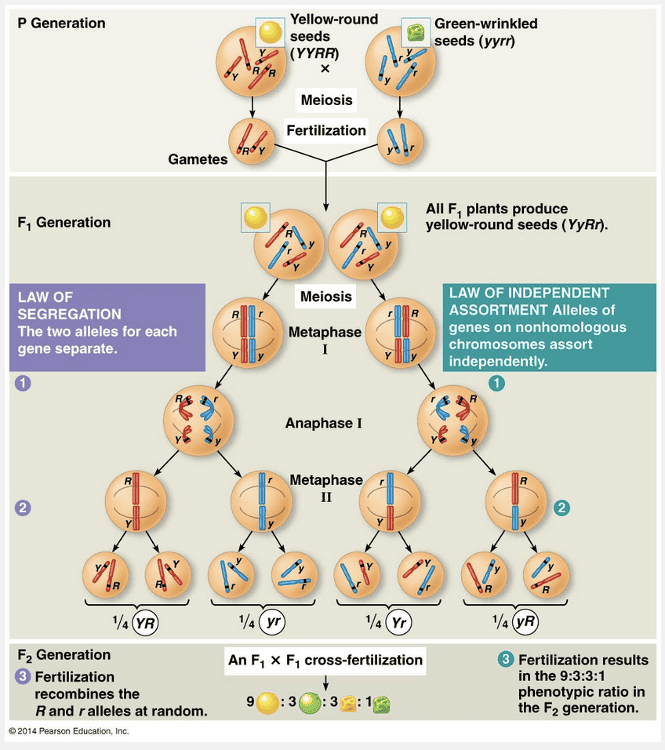
segregation; homologous pairs; independent assortment; alleles; independently
Ex.
The ability to observe meiosis in gamete production supported Mendel’s first law of segregation, which applies when homologous pairs separate, and supported Mendel’s second law of independent assortment, which applies when alleles sort independently.
Using improved techniques of microscopy, cytologists worked out the process of mitosis in 1875 (see the drawing at the lower left) and the process of meiosis in the 1890s. Cytology and genetics converged as biologists began to see parallels between the behavior of Mendel’s proposed hereditary factors during sexual life cycles and the behavior of chromosomes: As shown in the figure below, chromosomes and genes are both present in pairs in diploid cells, and homologous chromosomes separate—and alleles segregate—during the process of meiosis. Furthermore, after meiosis, fertilization restores the paired condition for both chromosomes and genes.
“Independent assortment; homologous pairs; segregation; alleles; independently” and “independent assortment; homologous pairs; segregation; sister chromatids; independently” are incorrect because Mendel’s first law is the law of segregation, which applies when homologous pairs separate. “Segregation; sister chromatids; independent assortment; alleles; independently” is incorrect because during segregation, homologous pairs separate. “Segregation; homologous pairs; independent assortment; alleles; dependently” is incorrect because during independent assortment, alleles sort independently.
Compared to peas, fruit flies were thought to have no variations, until the discovery of a __________ fly by __________.
- female white-eyed; Krebs
- male white-eyed; Morgan
- female red-eyed; Krebs
- female white-eyed; Morgan
- male red-eyed; Morgan
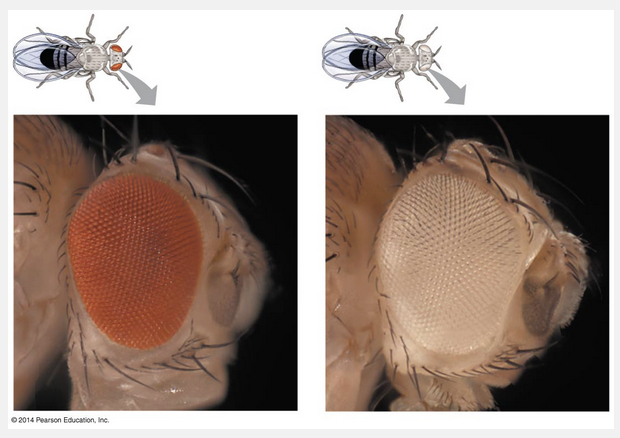
male white-eyed; Morgan
Ex.
Compared to peas, fruit flies were thought to have no variations, until the discovery of a male white-eyed fly by Morgan.
Although Mendel could readily obtain different pea varieties from seed suppliers, Morgan was probably the first person to search for different varieties of the fruit fly. He faced the tedious task of carrying out many matings and then microscopically inspecting large numbers of offspring in search of naturally occurring variant individuals. After many months of this, he grumbled, “Two years’ work wasted. I have been breeding those flies for all that time and I’ve got nothing out of it.” Morgan persisted, however, and was finally rewarded with the discovery of a single male fly with white eyes instead of the usual red. The phenotype for a character most commonly observed in natural populations, such as red eyes in Drosophila, is called the wild type. Traits that are alternatives to the wild type, such as white eyes in Drosophila, are called mutant phenotypes because the alternatives are due to alleles assumed to have originated as changes, or mutations, in the wild-type allele.
“Male red-eyed; Morgan,” “female white-eyed; Morgan,” “female white-eyed; Krebs,” and “female red-eyed; Krebs” are incorrect because Morgan discovered a single male fly with white eyes instead of the usual red eyes.
When crossing over occurs between two linked genes in an F1 dihybrid testcross, the frequency of the parental types will always __________ the frequency of the recombinant types when compared to Mendel’s unlinked genes.
- be greater than
- be recessive to
- be equal to
- be dominant to
- be less than
be greater than
Ex.
The chromosome theory of inheritance states that __________.
- genes occupy specific positions on chromosomes, homologous chromosomes segregate from each other during meiosis, and chromosomes assort independently during meiosis
- genes occupy specific positions on chromosomes
- homologous chromosomes segregate from each other during meiosis
- chromosomes assort independently during meiosis
- genes occupy specific positions on chromosomes and homologous chromosomes segregate from each other during meiosis
genes occupy specific positions on chromosomes, homologous chromosomes segregate from each other during meiosis, and chromosomes assort independently during meiosis
Ex.
The chromosome theory of inheritance states that genes occupy specific positions on chromosomes, homologous chromosomes segregate from each other during meiosis, and chromosomes assort independently during meiosis.
Using improved techniques of microscopy, cytologists worked out the process of mitosis in 1875 and meiosis in the 1890s. Cytology and genetics converged when biologists began to see parallels between the behavior of chromosomes and the behavior of Mendel’s proposed hereditary factors during sexual life cycles: Chromosomes and genes are both present in pairs in diploid cells; homologous chromosomes separate and alleles segregate during the process of meiosis; and fertilization restores the paired condition for both chromosomes and genes.
Around 1902, Walter S. Sutton, Theodor Boveri, and others independently noted these parallels, and the chromosome theory of inheritance began to take form. According to this theory, Mendelian genes have specific loci (positions) along chromosomes, and it is the chromosomes that undergo segregation and independent assortment.
Genomic imprinting in mammals appears to primarily affect genes involved in __________.
- digestion
- embryonic development
- function of the nervous system
- sex determination
- vision
embryonic development__________ is the failure of __________ to separate in meiosis I or the failure of __________ to separate in meiosis II.